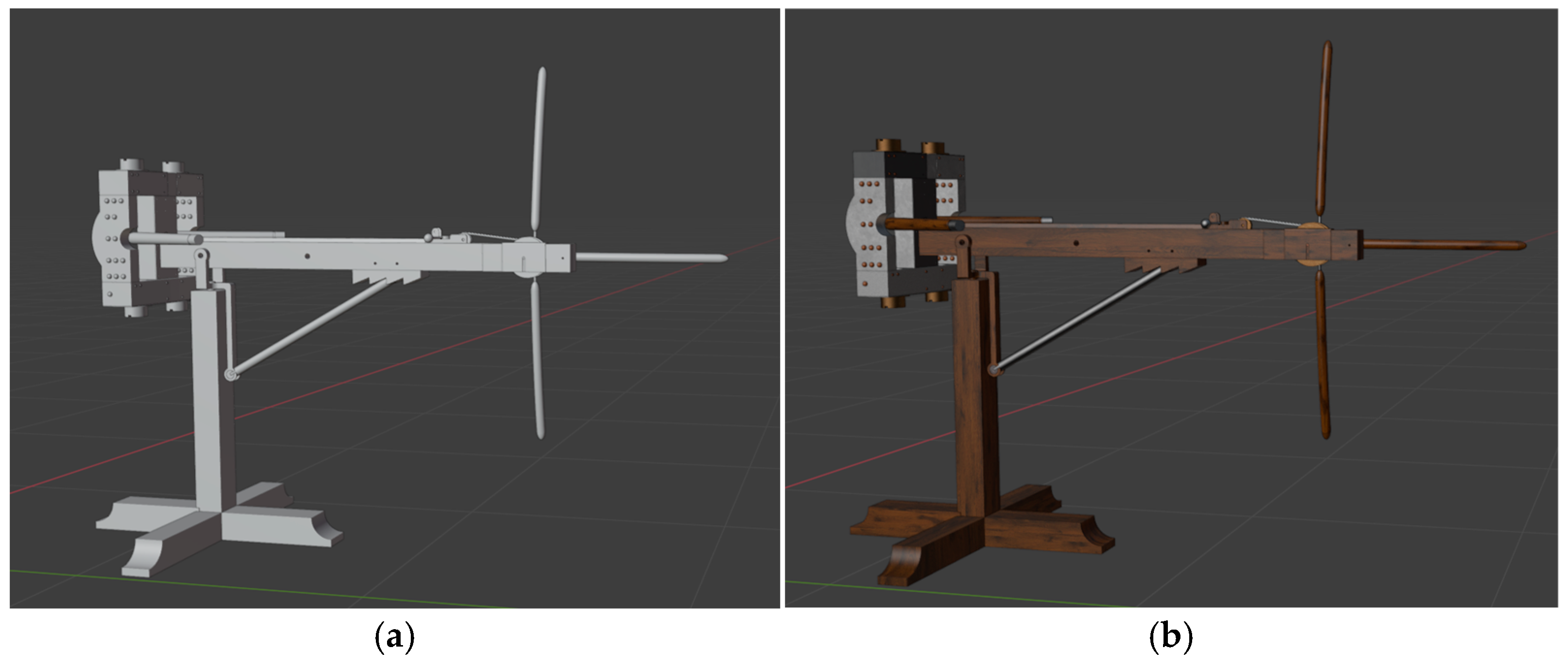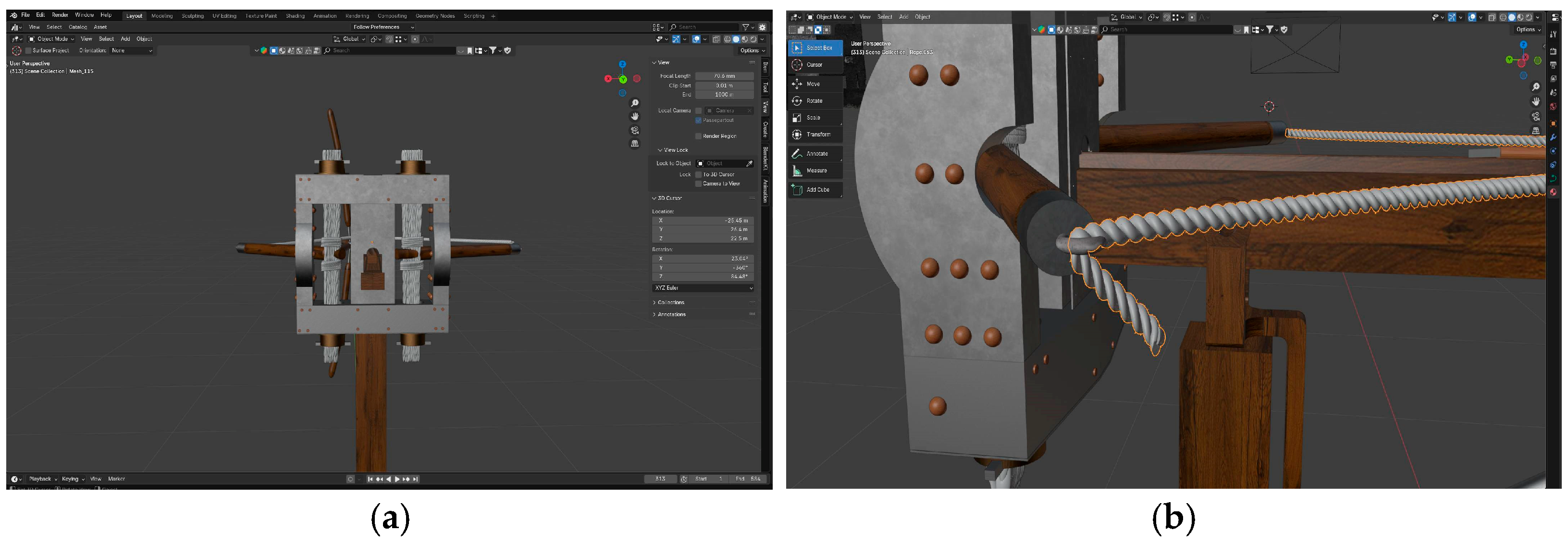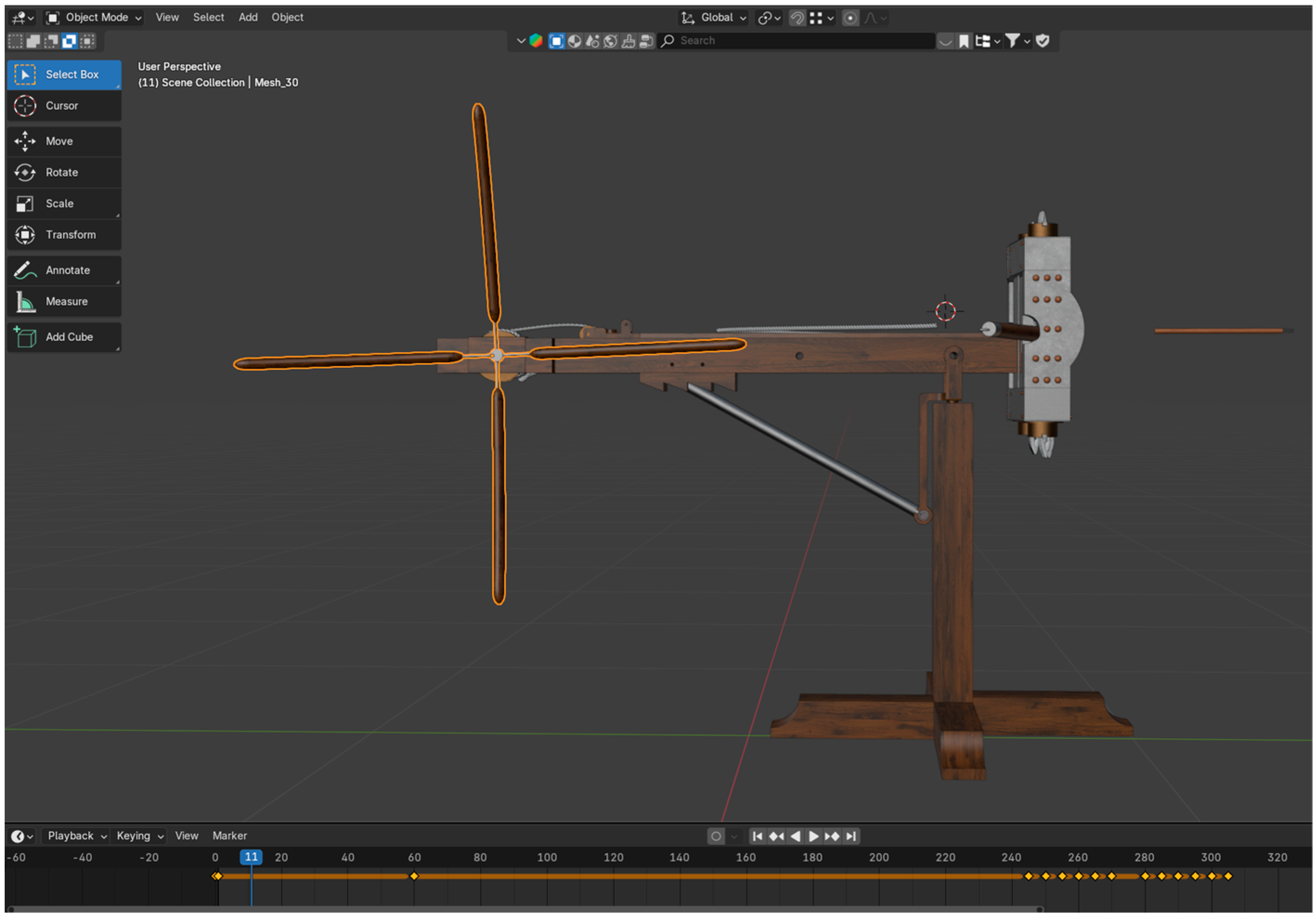Access to Digital Cultural Heritage: Exploring Future Perspectives Through Open Tools of Research †
Abstract
1. Introduction
2. Materials and Methods
2.1. ATON Framework
- Integrated front-end “as is” (if it meets the requirements) to present 3D models and scenes to end-users without the need for any code development;
- Custom extension, if one wishes to expand the front-end functionality;
- Offline: ATON is installed directly on the device on which it is consumed, without requiring any connection, such as for use in a kiosk or touchscreen display in a museum;
- Local network: ATON can stream an interactive experience via an access point to nearby users, who can use a variety of devices without needing the internet, but with a configured local network;
- Online: via a remote server, where ATON can be hosted, allowing global access to content from anywhere in the world [12].
2.2. Blender
- Defining textures and materials to realistically recreate the visual and chromatic characteristics of the original object (wood, metal, etc.) as shown in Figure 1;
- Lighting the scene to create a realistic setting;
- Rendering and post-production to produce photorealistic images for use in ATON, project communication, and storytelling.
- Animation, simulating the dart throw and the movement of the mechanical components of the scorpion.
3. Results and Discussion
4. Conclusions
- -
- Text contrast: To ensure readability, high contrast between text and background is crucial. The WCAG recommends a contrast ratio of at least 4.5:1 for normal text and 3:1 for large text [31];
- -
- Text size: The text size should meet the minimum recommendation of 16px for the main body of text [31];
- -
- Text descriptions for non-text content: It is important to provide detailed text descriptions for all non-text content. For instance, comprehensive descriptions should accompany each phase of the 3D animations and the movements of the machines. This will enable users to understand the operations even when using a screen reader [31];
- -
- Subtitles and Italian Sign Language (LIS): Subtitles should be included for videos and audio recordings, as well as content in Italian Sign Language (LIS) and other international sign languages [31];
- -
- Simple and intuitive UI: A user-friendly and intuitive interface is essential for ensuring a positive experience for all users [31].
Author Contributions
Funding
Institutional Review Board Statement
Informed Consent Statement
Data Availability Statement
Conflicts of Interest
References
- Council of the European Union. Council Conclusions of 21 May 2014 on Cultural Heritage as a Strategic Resource for a Sustainable Europe (2014/C 183/08) 2014. Available online: https://eur-lex.europa.eu/legal-content/EN/TXT/?uri=planjo:20140523-025 (accessed on 21 March 2025).
- Drafted by the Central Institute for the Digitalization of Cultural Heritage—Digital Library of the Italian Ministry of Culture within the National Plan for the Digitalization of Cultural Heritage 2022–2026. Available online: https://commission.europa.eu/projects/national-plan-digitalisation-cultural-heritage_en (accessed on 22 March 2025).
- Bertacchi, S.; Gonizzi Barsanti, S.; Rossi, A. Geometry of Wall Degradation: Measuring and Visualising Impact Craters in the Northern Walls of Pompeii. SCIRES-IT-Sci. Res. Inf. Technol. 2024, 14, 111–128. [Google Scholar] [CrossRef]
- Rossi, A.; Gonizzi Barsanti, S.; Bertacchi, S. Naturali o Antropiche? Misura e Visualizzazione Delle Cavità Murarie in Cerchie Urbiche|Natural or Anthropic? Measurement and Visualisation of Wall Cavities in City Walls. In Proceedings of the Misura/Dismisura|Measure/Out of Measure. Ideare Conoscere Narrare|Devising Knowing Narrating; FrancoAngeli s.r.l.: Milano, Italy, 2024; pp. 1957–1978. [Google Scholar] [CrossRef]
- Rossi, A. The Survey of the Ballistic Imprints for a Renewed Image of Unearthed Pompeii. Nexus Netw. J. 2024, 26, 307–324. [Google Scholar] [CrossRef]
- Russo, F.; Russo, F. Tormenta. Venti Secoli di Artiglieria Meccanica; Stato Maggiore Esercito: Roma, Italy, 2002. [Google Scholar]
- Viola, F.; Idone Cassone, V. L’arte del Coinvolgimento: Emozioni e Stimoli per Cambiare il Mondo; Microscopi, Hoepli Editor: Milano, Italy, 2017; pp. 1–7. [Google Scholar]
- Bonacini, E.; Marangon, G. Lo storytelling Digitale Partecipato come Strumento Didattico di Divulgazione Culturale. Cuad. Filol. Ital. 2021, 28, 405–425. [Google Scholar] [CrossRef]
- Vaglio, M.G. Lo storytelling per i beni culturali: Il racconto. In Racconti da Museo: Storytelling d’Autore per il Museo 4.0; Dal Maso, C., Ed.; Edipuglia: Bari, Italy, 2018; pp. 27–51. [Google Scholar]
- Costa, S.; Cordera, P.; Poulot, D. Storytelling? Una narrazione a più voci. In Storytelling: Esperienze e Comunicazione del Cultural Heritage; Costa, S., Cordera, P., Poulot, D., Eds.; Bononia University Press: Bologna, Italy, 2022; pp. 1–7. [Google Scholar]
- Dal Maso, C. Storytelling: Perché. In Racconti da Museo: Storytelling d’Autore per il Museo 4.0; Dal Maso, C., Ed.; Edipuglia: Bari, Italy, 2018; pp. 11–25. [Google Scholar]
- ATON. Available online: https://osiris.itabc.cnr.it/aton/ (accessed on 26 March 2025).
- Blender. Available online: https://www.blender.org/ (accessed on 26 March 2025).
- Fanini, B.; Ferdani, D.; Demetrescu, E.; Berto, S.; D’Annibale, E. ATON: An Open-Source Framework for Creating Immersive, Collaborative and Liquid Web-Apps for Cultural Heritage. Appl. Sci. 2021, 11, 11062. [Google Scholar] [CrossRef]
- Gonizzi Barsanti, S.; Caruso, G.; Micoli, L.L.; Covarrubias Rodriguez, M.; Guidi, G. 3D Visualization of Cultural Heritage Artefacts with Virtual Reality Devices. Int. Arch. Photogramm. Remote Sens. Spatial Inf. Sci. 2015, XL-5/W7, 165–172. [Google Scholar] [CrossRef]
- Balzani, R.; Barzaghi, S.; Bitelli, G.; Bonifazi, F.; Bordignon, A.; Cipriani, L.; Colitti, S.; Collina, F.; Daquino, M.; Fabbri, F.; et al. Saving Temporary Exhibitions in Virtual Environments: The Digital Renaissance of Ulisse Aldrovandi—Acquisition and Digitisation of Cultural Heritage Objects. Digit. Appl. Archaeol. Cult. Herit. 2024, 32, e00309. [Google Scholar] [CrossRef]
- Pietroni, E.; Menconero, S.; Botti, C.; Ghedini, F. e-Archeo: A Pilot National Project to Valorize Italian Archaeological Parks through Digital and Virtual Reality Technologies. Appl. Syst. Innov. 2023, 6, 38. [Google Scholar] [CrossRef]
- Three.js. Available online: https://threejs.org/ (accessed on 31 March 2025).
- Ponchio, F.; Callieri, M.; Dellepiane, V.; Scopigno, R. Effective Annotations Over 3D Models. Comput. Graph. Forum 2020, 39, 89–105. [Google Scholar] [CrossRef]
- Khronos. Available online: https://www.khronos.org/gltf/ (accessed on 26 March 2025).
- Rossi, A.; Formicola, C.; Gonizzi Barsanti, S. Ingegna Romana. Dalle Fonti ai Modelli, dai Reperti alle Ricostruzioni. Diségno 2024, 14, 229–238. [Google Scholar] [CrossRef]
- Hosen, M.S.; Ahmmed, S.; Dekkati, S. Mastering 3D Modeling in Blender: From Novice to Pro. ABC Res. Alert 2019, 7, 169–180. [Google Scholar] [CrossRef]
- Blender 4.3 Manual. Available online: https://docs.blender.org/manual/en/4.3/index.html (accessed on 2 April 2025).
- Belec, A. Photorealistic Materials and Textures in Blender Cycles: Create Impressive Production-Ready Projects Using One of the Most Powerful Rendering Engines, 4th ed.; Packt Publishing Limited: Birmingham, UK, 2023; pp. 351–363. [Google Scholar]
- Brubaker, S. Realizing 3D Animation in Blender: Master the Fundamentals of 3D Animation in Blender, from Keyframing to Character Movement; Packt Publishing Ltd.: Birmingham, UK, 2024; pp. 4–17. [Google Scholar]
- Zambruno, S.; Vazzana, A.; Orlandi, M. Tecnologia, Beni Culturali e Turismo: I Tour Virtuali (Virtual Tours) come strumento per una corretta comunicazione dei Beni Culturali. Stor. Futuro 2014, 34, 1–4. [Google Scholar]
- Meier, C.; Saorín, J.L.; Díaz Parrilla, S.; Bonnet De León, A.; Melián Díaz, D. User Experience of Virtual Heritage Tours with 360° Photos: A Study of the Chapel of Dolores in Icod de Los Vinos. Heritage 2024, 7, 2477–2490. [Google Scholar] [CrossRef]
- Fanini, B.; Ferdani, D.; Demetrescu, E. Temporal Lensing: An Interactive and Scalable Technique for Web3D/WebXR Applications in Cultural Heritage. Heritage 2021, 4, 710–724. [Google Scholar] [CrossRef]
- Fanini, B.; Pagano, A.; Pietroni, E.; Ferdani, D.; Demetrescu, E.; Palombini, A. Augmented Reality for Cultural Heritage. In Springer Handbook of Augmented Reality; Nee, A.Y.C., Ong, S.K., Eds.; Springer International Publishing: Cham, Switzerland, 2023; pp. 391–411. [Google Scholar] [CrossRef]
- Rubano, V.; Vitali, F. Making accessibility accessible: Strategy and tools. In Proceedings of the 2021 IEEE 18th Annual Consumer Communications & Networking Conference (CCNC), Las Vegas, NV, USA, 9–12 January 2021; pp. 1–6. [Google Scholar] [CrossRef]
- Web Content Accessibility Guidelines (WCAG). Available online: https://www.w3.org/TR/WCAG21/ (accessed on 2 May 2025).
- User Experience Questionnaire. Available online: https://www.ueq-online.org/ (accessed on 2 May 2025).



Disclaimer/Publisher’s Note: The statements, opinions and data contained in all publications are solely those of the individual author(s) and contributor(s) and not of MDPI and/or the editor(s). MDPI and/or the editor(s) disclaim responsibility for any injury to people or property resulting from any ideas, methods, instructions or products referred to in the content. |
© 2025 by the authors. Licensee MDPI, Basel, Switzerland. This article is an open access article distributed under the terms and conditions of the Creative Commons Attribution (CC BY) license (https://creativecommons.org/licenses/by/4.0/).
Share and Cite
Casadei, V.; Di Modica, G. Access to Digital Cultural Heritage: Exploring Future Perspectives Through Open Tools of Research. Eng. Proc. 2025, 96, 10. https://doi.org/10.3390/engproc2025096010
Casadei V, Di Modica G. Access to Digital Cultural Heritage: Exploring Future Perspectives Through Open Tools of Research. Engineering Proceedings. 2025; 96(1):10. https://doi.org/10.3390/engproc2025096010
Chicago/Turabian StyleCasadei, Veronica, and Giuseppe Di Modica. 2025. "Access to Digital Cultural Heritage: Exploring Future Perspectives Through Open Tools of Research" Engineering Proceedings 96, no. 1: 10. https://doi.org/10.3390/engproc2025096010
APA StyleCasadei, V., & Di Modica, G. (2025). Access to Digital Cultural Heritage: Exploring Future Perspectives Through Open Tools of Research. Engineering Proceedings, 96(1), 10. https://doi.org/10.3390/engproc2025096010






